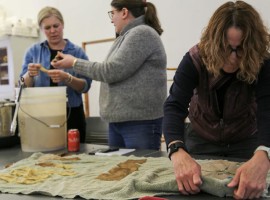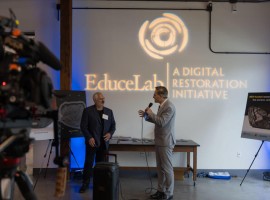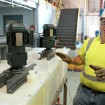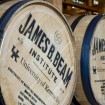Organic Chemistry and Student Success with Susan Odom
Four years ago, I was interviewing John Anthony in chemistry about his work on solar cells and light-emitting diodes (LEDs). He mentioned this crazy undergraduate student, who used to work in his lab, who constantly dyed her hair. She made bright orange and fluorescent pink LEDs that matched her “hair color of the week.” The science behind these organic compounds was intriguing, he told me, although he admitted there wasn’t much demand for those shades of LEDs in consumer electronics.
Fast forward to today, that undergrad—Susan Odom—is now an assistant professor of chemistry with her own lab. Odom tells me the exact same story—as she points out the pink hair photo that used to hang in Anthony’s lab. Odom credits that LED project as the experience that convinced her to pursue a research career.
In the Qualitative Organic Analysis Laboratory course she teaches, the undergrads make the same compounds “to match their shirts, not their hair,” Odom says with a laugh. She hopes to inspire future researchers with fun projects, but also challenge them by developing curriculum that has them do unique experiments.
“You can’t look at your neighbor to feel reassured that your outcome looks like theirs,” Odom explains. “I think it’s important for students to not have that reassurance and to feel comfortable experiencing discomfort. Being uncomfortable allows us to make changes. Being uncomfortable allows us to make significant progress and advance research.”
Listen to Odom’s podcast for more on training students, next-generation battery research, and the connection between chemistry and cooking.
Alicia: Welcome to the research podcast. I'm Alicia Gregory, Director of Research Communications at the University of Kentucky. Susan Odom is an assistant professor of Chemistry at the University of Kentucky. She did undergraduate research with mentor John Anthony, who is now her colleague in the chemistry department. When I asked her to tell me about her first research project, she shares a throwback story about pink hair and matching light emitting diodes.
Susan Odom: I worked with John Anthony, who’s also still in the Chemistry department, and was my undergraduate mentor at the time. So, my first project at the University of Kentucky involved the synthesis of tetracene derivatives for light emitting diodes. So, these compounds would be the emissive component of a light emitting diode. I was creating, in one to two steps, brightly colored materials. They were pink to orange, sometimes red, and at the time I also dyed my hair pink for fun, and sometimes they matched the color of my hair. So, we would have photos of a vial of a compound next to my hair color of the week. And, the synthesis was really fun to create materials where I could control the color, and I could see, not just on a molecular level through spectroscopy, but also by looking at the material, just visually, and telling the difference between the colors of compounds based on the components that were going into the molecular design. And, that project, I not only made the materials themselves, but fabricated the light emitting diodes using those materials. So, I got to see the color of the materials in the solid state, as well as the color of the light that was emitted when I made the device. And, that, going from synthesis to fabrication of the appropriate device, was really what was exciting for me. And, how... that's how I identified that yes, I do want to go into research.
Alicia: John Anthony actually told us that story years ago when we interviewed him.
Susan Odom: Yeah. I found a... this photo. It says "who’s this girl?" in his laboratory, and it's me with pink hair. It's somewhere over there.
In the class I'm teacher, Qualitative Organic Analysis Laboratory, the students are making the same compounds. So, some of them are making the compounds that I made when I was an undergraduate. And, it's not their hair that's matching, but their shirts. We've got a photograph of a student who’s a perfect match, as far as I can tell, of the solution of her compound and the color of her neon orange-y-pink tee shirt.
Alicia: What really motivated you to go in the direction of becoming a researcher? Was it something as a kid, something that caught your attention? Or did it develop later?
Susan Odom: I remember as early as second grade that I wanted to do something involving education. I thought, I'll finish second grade, and then I'll teach second grade. I used to force my sister to be... play school with me. So, she would have to learn what I was learning. So, she got to learn a year ahead in the course material. And somewhere along the way, I guess I lost that- that desire. When I got to Organic Chemistry, with Mark Meier, our current department chair, then I thought, I would like to teach this. And, I... I looked at Mark Meier and John Anthony, and other faculty members in the chemistry department, and I was intrigued by the idea of having their job. And, so, I was going from the idea of teaching my sec... doing my second grader's job, to doing the professor's job for my current class. So, that's where I got interested in the idea.
Alicia: Tell me a little about the area of research you focused on in your career thus far.
Susan Odom: Well, the area of research I've focused on thus far, has been the development of organic compounds for electrochemical energy storage applications. An example of that would be a lithium-ion battery. That's the more commonly used battery in consumer electronic devices, and now in electric vehicles, such as the Tesla and Chevy Volt. And, my research also involves putting organic compounds into new types of batteries, such as non-aqueous redox flow systems. And, those are systems that are quite infantile in their development. We're one of the first groups look at organic compounds for these systems.
Alicia: Why are people looking at those kind of new systems?
Susan Odom: Redox flow batteries are of interest for connection to the electrical grid. They're a lower capacity battery, so it's not one that you would ever put in your watch, or your cellphone, or in an electric vehicle, because there's not enough power for the space. But, if the lifetimes of these systems are better than in lithium-ion batteries, they could be used for longer-term storage, where mobility's not important. A system that has a long lifetime, we're talking 20 years at minimum, opposed to a lithium-ion battery, which is probably 7 years at the best case scenario, then the batteries can be connected to the grid to store power from renewable energy sources, like solar power, and wind, which currently have very little capacity for storage with our electrical grid.
Alicia: What are you most excited about in terms of the impact of your research in the near future?
Susan Odom: For the near future, I'm most excited about seeing how my materials perform in non-aqueous redox flow batteries. I think that the combination of having an organic chemistry background, and working collaboratively with engineers at Oak Ridge National Laboratory and Massachusetts Institute of Technology is going to enable these collaborations to have the strengths of experts on both sides of the table, from molecular design to the kinds of characterizations that I'm not equipped to do, or not an expert at doing. I'm working with John Anthony on that project to develop electrode materials for flow batteries. Where, I'm working on the positive side, ‘cause that's my group's expertise, and then the precursors to some of his compounds for field effect transistors and solar cells also turn out to be good negative electrode materials in these flow systems. So, with me working on the positive half, and him working on the negative half, and then having an expert in battery testing evaluate our materials in combination, I suspect that we'll have a high-impact publication in the near future.
Alicia: What is your favorite part of being a researcher?
Susan Odom: I think the most exciting part of doing research, is creating publications. And, I like the challenge of putting together concise story that is the best wording and best combination of images to convey a concept to the readership that I feel is most relevant to a research project. And, I think that there's a balance of determining what is the most important figure one, what is the most important scheme one, and not having any extra information that might detract from that main story, or not... also not leaving anything out. And, creating images that are visually appealing and consistent with one another, that's enjoyable. As well as creating artwork for table of contents, and cover articles, that allows some of my groups' and my own taste in art be part of the creative process.
Alicia: It kind of brings all those things together; the science and the art part.
Susan Odom: Yeah. And, my group has been good at creating artistic work for publications. And, for Science is Art competitions. We recently competed in the Science is Art competition at the Materials Research Society. And, our artwork was selected to be part of the competition.
Alicia: What has been the most fulfilling moment for you, thus far, in terms of your research?
Susan Odom: Well, I'd say that it would have to be a competition between, knowing that I've created materials that have been licensed through a patent that are now being used for testing. And field effect transistors, for example. That was a result of my undergraduate research. So, it's a long-term, fulfilling experience to think that I've done something that's important enough for someone else to invest financially.
But, also in competition in with that, in my own research group, I have found it very rewarding to see students realize their own success. Having students become authors on papers is quite rewarding. One student, Rachel Burrows, who's now a medical student at UK, worked on a project on developing catalysts for carbon dioxide sequestration. And, that paper, it took a few years to finally get it published, but now it's a Dalton Transactions article, and she's the first author. And that's the first publication from my group where an undergraduate student is the first author. And, that was very exciting.
Alicia: How has your research informed the way you train students?
Susan Odom: I remember as an undergraduate student going through certain classes where everyone does the same experiment, and you can look to your neighbor and see what you're doing and then feel reassured that okay, my outcome looks the same as their outcome. And, I think that it's important for students to not have that reassurance and to feel comfortable experiencing discomfort, and unsureness. And, many students don't get that experience until they're in a research group. And, I remember the uncomfortable feeling of not knowing the answer and not having the solutions manual. And, that's why I think it's really important, for undergraduates especially, to get into research laboratories. To make sure they have a unique experience, where no one knows an answer. Because that is the challenge that I give to my group members, is to be comfortable with change, and be comfortable with uncertainty. Being uncomfortable allows us to make the changes. Being uncomfortable allows us to make the significant progress and advance research and energy collection and storage.
And, I've also translated that into the classroom setting for the Qualitative Organic Analysis laboratory. I've redesigned that course so that students have experience and techniques that involve the creation, and purification, and analysis of organic materials. And, I worked with a TA, Anthony Petty, who is a graduate student at UK, to develop a set of four experiments where the students retain their unique experiences and they all make different materials from one another, yet it's a scalable set of experiments. So that it doesn't become too difficult to manage due to its uniqueness. So, the students make acene derivatives that are highly colored and fluorescent, and then, in the last experiment, they get to choose from numerous projects that... that tailor to their interests, but allow them to have something unique from other students. Even the analysis is different from one student to another, as far as what experiments they do.
Alicia: Let's talk a little bit about what inspires you about the University of Kentucky.
Susan Odom: The University of Kentucky, is a place where I was quite excited to get an interview. I didn't expect to have that as one of the 50 places I applied to. And the combination of different faculty, and materials research, and energy storage and collection, both within Arts and Sciences, but also in Engineering, and at the Center for Applied Energy Research. That combination allows for collaborative projects that I wouldn't have had the opportunity to participate in at other institutions.
Alicia: What do you do outside the lab that you enjoy the most?
Susan Odom: When I was in graduate school, my advisor found out that I was just eating rice and noodles, and macaroni and cheese, and he said that, "you just can't be an organic chemist, someone who creates materials with complex procedures in the lab, and not do the same thing at home." And, he said, "You must learn how to cook. It's part of your graduation requirement." So, I started watching the Food Network and saw how chefs would just do things on the fly without recipes, and then, I thought, "oh, well I can do this, too." And that's when I started really working in the kitchen, my second and third years of grad school. I like to experiment with new recipes and learning new recipes, but then also modifying those recipes to make them sometime better, sometimes worse, but it's just an experiment to see what's going to happen. I've been doing molecular gastronomy experiments which has actually turned into an outreach activity through the University and schools in the area.
Alicia: Thanks Susan, and thank you for listening to the research podcast. Join us next time to learn more about research at the University of Kentucky and visit our site; reveal.uky.edu.





